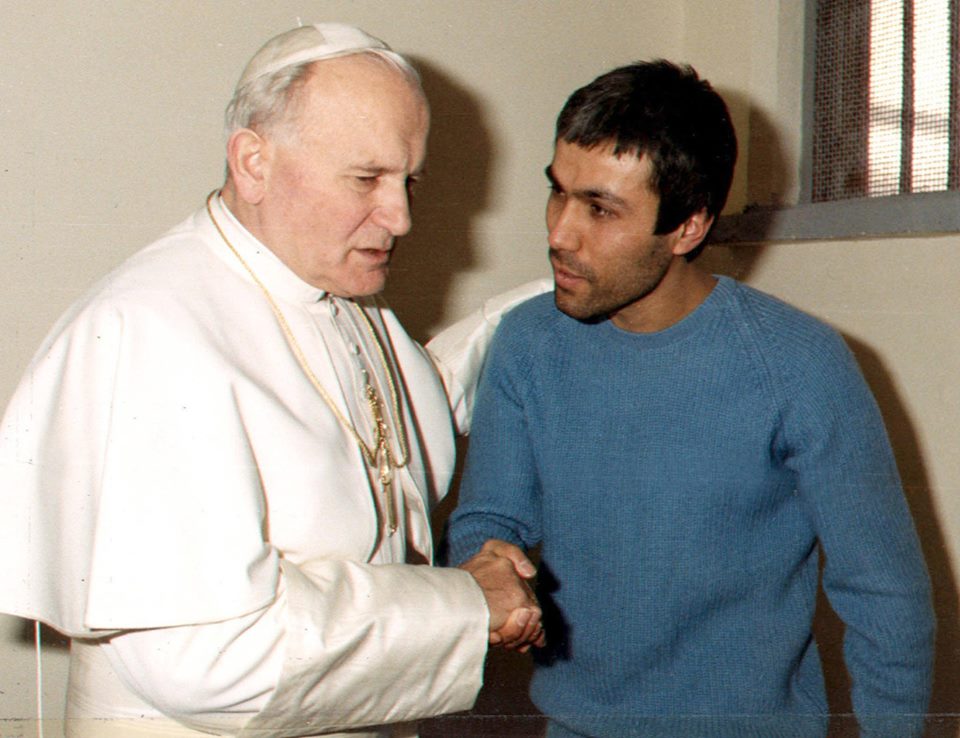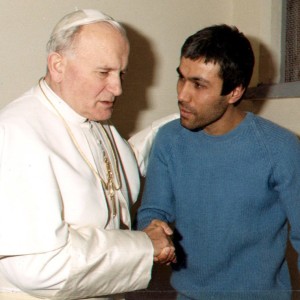I celebrated St. John Paul II’s feast day today (now yesterday: October 22nd) by praying the Luminous Mysteries while holding a reliquary containing some of his blood. It’s one of those amazing experiences I never dreamed I’d be able to do. How did you celebrate (or how are you celebrating) his feast day?
This is one of my favorite photos of him:

it’s of his meeting with Mehmet Ali Ağca in prison. Ağca was in prison, by the way, for the attempted murder of… John Paul II.
This beautiful encounter, by the well, helps to reveal why God calls King David a man after His own heart.

Touching story, reminds me of the Lord’s
You can definitely see the love between the two. It’s very beautiful and full of tenderness on both sides. If that’s not a merciful and loving father…I don’t know what is.
This photo also demonstrates how it is not only words that express the Gospel message. It is also acts, which are living expressions of faith without words. Acts of love are often forgotten when discussing the power of preaching the Gospel. And this might be because Christians are often focused on the ‘Word’ being preached. But we also know that the ‘word’ itself testifies to the power of ‘acts’ in the conversion of others. This is demonstrated most clearly by the acts of Christ Himself as taught in the Gospels. Jesus performed miracles, which are acts, that impressed the populations in a very profound way. He also demonstrated friendliness by eating with and associating with ‘sinners and tax collectors’. So, these very acts and examples of Christ were worth a probably thousand, if not millions, of His words.
And this is one other reason why our ‘works’ are so necessary. And this is NOT so that we are justified by them. But because by our ‘works’, we prove by our example that we ‘practice what we preach’. And moreover, by our ‘works’, we teach others things that cannot be taught by the mouth. Like as witnessed in the picture above, the Pope’s expressions of love communicate things that a multitude of words could never suffice to do. WE might say, if a word is worth a thousand pictures, then a ‘holy act’ is probably with a thousand pictures…if not a million.
I guess you might conclude that I really like this picture. The link to the older post is excellent also. And I think it’s probably needless to say that pretty much all of Joe’s posts are of the highest spiritual caliber. So, I’m glad to see ones that I’ve missed when reading his older posts.
error above: “word is worth a thousand pictures”…should be ‘picture is worth a thousand words’.
One more comment on David being ‘a man after my own heart’, as detailed in the linked post, above.
It appears as if the parallelisms discussed between the mercy, tenderness and love of David for his rebellious son Absolom, Jesus offering His life for us on the Cross, and this beautiful act of Pope John Paul of completely forgiving his assailant, are very accurate and suitable. Everything in these three stories exudes love, mercy, and concern for those, it would seem, do not really deserve such love, mercy and concern.
And this reminds me also of Moses and how he was continually praying for, and suffering for, his rebellious people Israel as they traveled through the desert in the Book of Exodus. So Moses, also, appears to belong to this ‘club of love and mercy’, and thus is another… ‘man after my own heart’.
In some ways, the raising of the ‘bronze serpent’ in the desert also seems to have significance to these accounts. As Jesus says: “And as Moses lifted up the serpent in the desert, so must the Son of man be lifted up: [15] That whosoever believeth in him, may not perish; but may have life everlasting.”
All of these accounts, and Pope John Paul II included, seem to be connected together by the theme of ‘redemption’ through love, mercy, sacrifice and forgiveness… and, it seems also, the recognition of one’s own sins, and the accepting of such love, mercy and forgiveness.